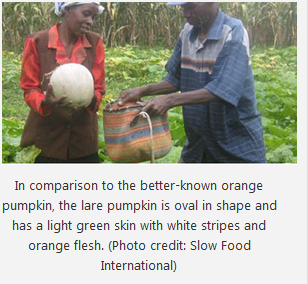 On the edge of the Mau Forest in Kenya, the residents of the Lare village are using their local pumpkin variety for more than jack-o-lanterns or pies.
On the edge of the Mau Forest in Kenya, the residents of the Lare village are using their local pumpkin variety for more than jack-o-lanterns or pies.
The Lare village is located in a part of the Rift Valley where rainfall has become increasingly erratic, likely as a result of climate change. In August 2009 during an interview with IRIN published in AllAfrica, Samuel Karanja, a 70 year old farmer from the region, described the farmland as, “stunted, barren fields of parched browns and pallid yellows in what should be tall, lush and green, bursting with life.” The decreased quality of land was the result of a severe drought that caused massive crop failures in what is considered the “bread-basket” of Kenya. But lare pumpkins, because they are adapted to harsh conditions, are becoming an important source of food and income for farmers.
In comparison to the better-known orange pumpkin, the lare pumpkin is oval in shape and has a light green skin with white stripes and orange flesh. This variety of pumpkin is a creeping and climbing plant with broad leaves and extensive vines that can be cultivated with other vegetable species. The fruit, seeds, leaves, and vines from the pumpkins provide good mulch for the soil in various climate conditions, providing a more favorable environment for other crops to grow. Nearby crops receive additional perks by being grown close to the pumpkin. The bright and colorful flowers of the lare plant attract bees and other pollinators that then pollinate other plants.
Pumpkins are extremely important vegetables throughout sub-Saharan Africa. Both the fruit and leaves are edible, ensuring that no part of the pumpkin goes to waste. One popular dish in Kenya called kimito uses pumpkin leaves, potatoes and broad beans. The flesh of the pumpkin can also be made into flour, mixing it with wheat flour, and used to make chapatti (flat bread) and maandazi (doughnuts). And, lare pumpkin seeds can be milled into flour used in porridge and for medicinal purposes, as well as eaten on their own when boiled or dried.
Guest Post: By Evelyn Drawec

Danielle Nierenberg, an expert on livestock and sustainability, currently serves as Project Director of State of World 2011 for the Worldwatch Institute, a Washington, DC-based environmental think tank. Her knowledge of factory farming and its global spread and sustainable agriculture has been cited widely in the New York Times Magazine, the International Herald Tribune, the Washington Post, and
other publications.
Danielle worked for two years as a Peace Corps volunteer in the Dominican Republic. She is currently traveling across Africa looking at innovations that are working to alleviate hunger and poverty and blogging everyday at Worldwatch Institute’s Nourishing the Planet. She has a regular column with the Mail & Guardian, the Kansas City Star, and the Huffington Post and her writing was been featured in newspapers across Africa including the Cape Town Argus, the Zambia Daily Mail, Coast Week (Kenya), and other African publications. She holds an M.S. in agriculture, food, and environment from Tufts University and a B.A. in environmental policy from Monmouth College.








